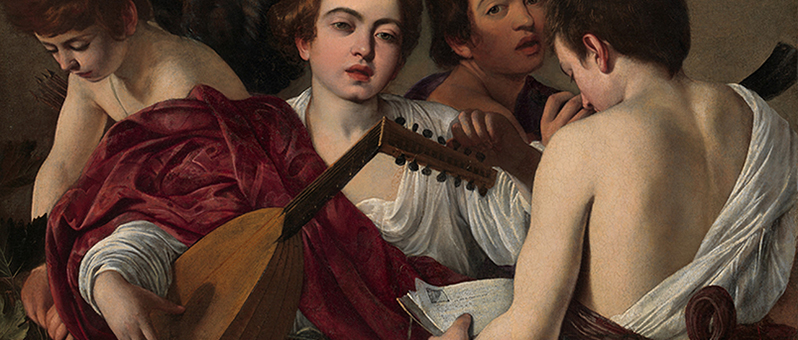
A Dazzling Duet: Image and Music in the Baroque period
With the anniversaries of two great baroque composers coming up this year, what better time to revisit this era’s splendour? The Italian composer Claudio Monteverdi (1567-1643), whose 450th birthday is celebrated this year, marks the beginning of the period, while the death of German musician Georg Philipp Telemann in 1767, exactly 250 ago, signals its end. The music of this era set the tone for the composers of the centuries that followed, and its influence still resonates today. The archive holds imagery of music and musicians that dates from the period itself, giving us a glimpse into how music was practiced and perceived in seventeenth- and early eighteenth-century Europe. Take a look at some of our musical highlights below.
The Magnificent Musician

Bust of Jean Baptiste Lully (1632-87) (bronze), , Gaspard Collignon (fl.1669 d.1702) / Church of Notre-Dame-des-Victoires, Paris; George Frederick Handel (1685-1759), Thomas Hudson (1701-79) / Private Collection; Portrait of Claudio Monteverdi (1567-1643) (oil on canvas), Domenico Fetti (1589-1624) / Galleria dell’ Accademia, Venice, Italy; Portrait of Georg Philipp Telemann (engraving), Georg Lichtensteger (1700-81) / Private Collection
Often employed by influential patrons such as royal courts and churches, the successful Baroque composer mixed in the highest circles of society. The Italian-born composer Jean-Baptiste Lully for example was a close friend of the French King Louis XIV, and German composer Georg Friedrich Handel came to London to work for the English royal family. The composer’s social status is sometimes reflected in their portraits, which can show the musician as an imposing presence like Collignon’s bust of Lully, or this commanding Italian portrait thought to be of Monteverdi. Hudson’s portrait of Handel depicts the musician in a velvet and brocade suit, in a country house setting not too different from aristocratic portraiture. Looking at these pictures however it does become clear that the musician is still very much a man of his craft, often portrayed with “tools of the trade” such as music scrolls. These musicians’ roles as artists may however not have been as free as we assume, as they created not just according to their own ideas, but also had to cater to the wishes of their patron.
Putting on a show
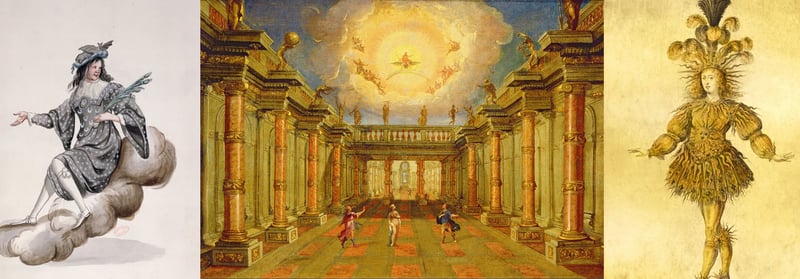
Costume for ‘Night’ for the ‘Ballet de la Nuit’ by Jean-Baptise Lully (1632-87) danced by Louis XIV, 23rd February 1653 (w/c on paper), French School, (17th century) / Bibliotheque de l’Institut de France, Paris, France; Act II, scene X: the courtyard of the King of Naxos (oil on canvas), Giacomo Torelli (1608-78) / Pinoteca Civica di Fano, Fano, Italy; King Louis XIV of France in the costume of the Sun King in the ballet ‘La Nuit’, 1653 (later colouration), French School, (17th century) / Bibliotheque Nationale, Paris, France
Baroque music is characterised by dramatic changes in volume and tempo, intricate ornaments and emotive stories (the genre of opera for example flourished in this period). For such showstopping music, the decor and costumes had to be equally lavish. Several drawings and paintings of stage sets survive, and they show a great interest not only in opulence (such as this drawing of Louis XIV’s costume for the ballet la Nuit), but also in grand architectural elements. Elaborate set designs by Giacomo Torelli show this reference to the architecture of Antiquity, infused with the luxurious ornamentation that characterised the Baroque building style.
Music in the Home
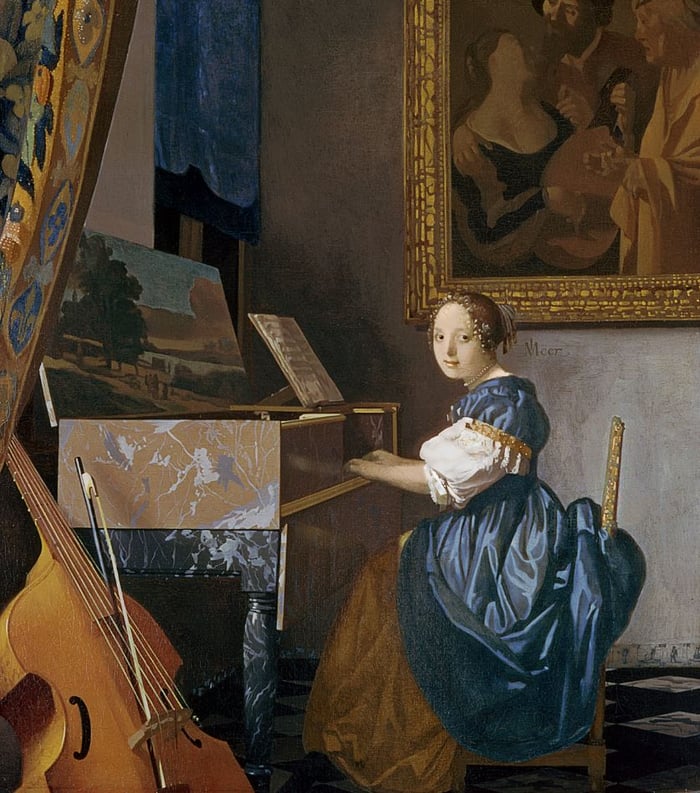
A Young Lady Seated at a Virginal, c.1670 (oil on canvas), Johannes Vermeer (1632-75) / National Gallery, London, UK
Music was however not limited to courts and theatres alone, and was also practiced in the seventeenth-century household. Netherlandish artists such as Johannes Vermeer and Gerrit Dou depict domestic scenes of bourgeois families with incredible detail, and musical instruments often feature in their compositions. The Harpsichord and Virginal (a smaller variety of the instrument) were new inventions of the period, and became incredibly popular for making music not only with great composers such as Johann Sebastian Bach, but also at home.
Music for the eyes
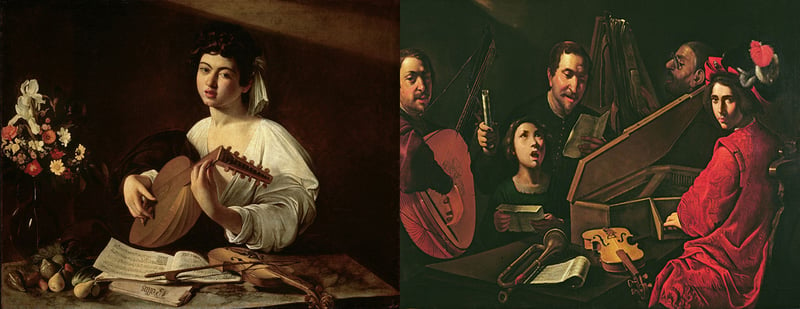
The Lute Player, c.1595 (oil on canvas), Caravaggio, Michelangelo da Merisi (1571-1610) / State Hermitage Museum, St. Petersburg, Russia; Concert with Musicians and Singers, c.1625 (oil on canvas), Pietro Paolini (1603-1681) / Louvre, Paris, France
One artist who gives music a seductive and mysterious appeal is Caravaggio. His Lute Player for example shows a very beautiful boy placed between what almost looks like a carefully arranged still life of instruments and flowers. There is no context or greater scene, nor do we know anything about the boy. This lute player is simply here for us to look at and enjoy. No artist does this quite like Caravaggio, however the dark backgrounds and isolated nature of his figures did inspire artists around him. Pietro Paolini’s group of musicians for example has the same mysterious glow.
Music and public life
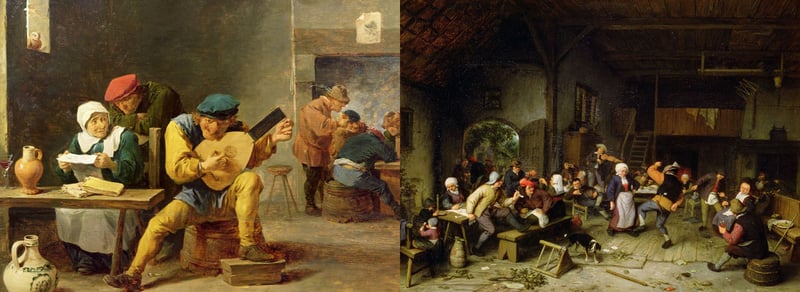
Peasants Making Music in an Inn, c.1635 (oil on oak), David Teniers the Younger (1610-90) / National Gallery, London, UK; Peasants Dancing in a Tavern, 1675 (oil on panel), Adrian Jansz van Ostade (1610-85) / Harold Samuel Collection, City of London
Very few pictures depict the true joys of music like tavern scenes. In the Netherlands such scenes were highly sought after, and the taverns and Inns inspired iconic artists like Jan Steen, David Teniers and Adriaen van Ostade. With crowded compositions full of drinking, dancing and singing peasants, these Dutch artists capture the spirit of the moment.
